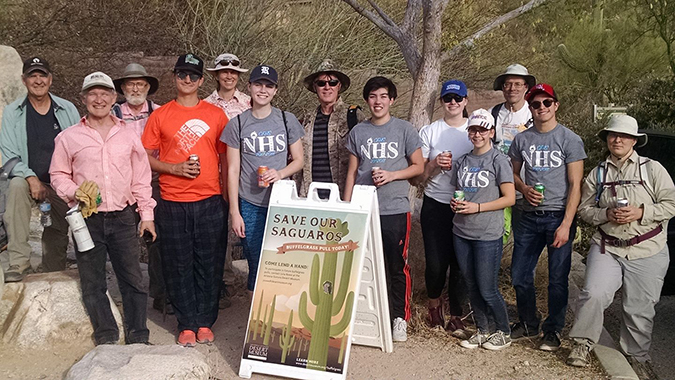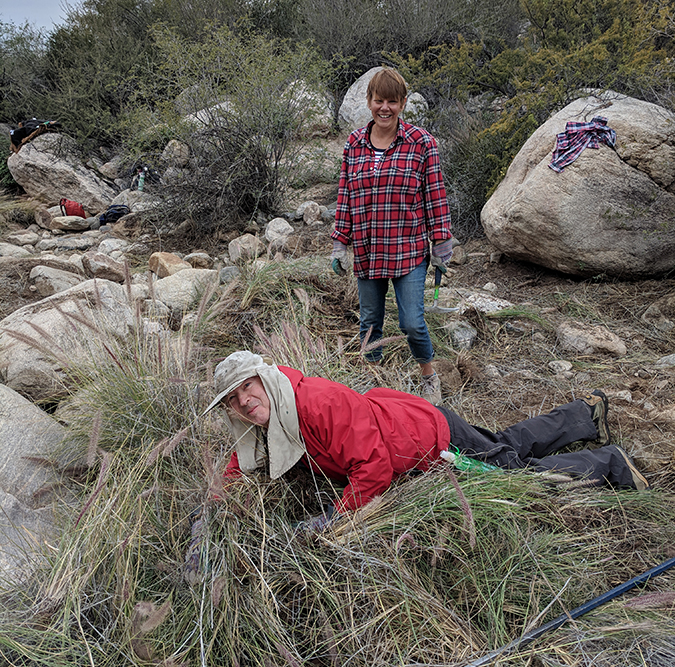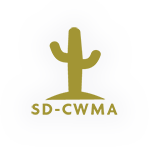How Do I Start a Volunteer Group?
First of all, good for you!! You are making an effort to help control invasive species. Getting started depends on where you are starting from. If you already have a group of concerned people that have identified a problem, then you are well on your way.
A volunteer group can be a great way to focus attention on a discrete area such as a park, or a neighborhood. Any place where there is an invasive weed that you feel compelled to control. First, make sure that you know the ownership of the land that you want to work on and be sure to obtain permission to control the target invasive plant. Check out Tucson Clean and Beautiful to see if there are any projects already happening near you. If there are not, you may be able to create your own project with Tucson Clean and Beautiful which can give you access to some resources and tools.
The next step is to get the word out to the community about the weed to increase enthusiasm for the group. You can
request a speaker to come and give a talk to your group about the plant, the speaker can also give you information about how to positively identify the plant and how to explain to others how to identify the plant.
Then you can post your first control event on social media; if it is buffelgrass or fountain grass you can post the event to the Buffelgrass.org web site.

Photo: Julia Rowe
Safety Tips For Buffelgrass Work Parties
Preparation:
- Wear sturdy shoes and long pants.
- Bring sun glasses, hat and work gloves.
- Bring tools — one caliche bar per three persons.
- Bring water (winter — 1+ pint per hour). More in summer.
- Caliche bar and gloves will be provided.
Safety:
- Do not work alone (minimum team 2-3 persons).
- Watch out for cacti, animal burrows, steep slopes, snakes, lizards, bees and scorpions (especially when moving rocks). If you find a Desert Tortoise, DO NOT pick it up.
- Stay clear of fellow worker using a caliche bar.
- Do not put your hand in any dark area without looking first. Sweep a caliche bar through the grass to encourage snakes and other desert residents to move on.
- If you hear thunder immediately discontinue working, especially any one working with a caliche bar.
- Carry miscellaneous medical items like bandages, antibiotic cream, anti-itch cream and tweezers.
- Drink plenty of water.
- Work at your own pace and rest at reasonable intervals.
Safety Working along Roadsides:
- Wear bright clothing if vests aren’t available.
- Never assume that drivers see you — make sure!
- Everybody help watch out for others.
- Set out Caution signs or other appropriate notice.
If a dangerous situation develops (e.g. bee swarm or animal acting strangely) leave area immediately.
Identification in Winter:
- Look for classic shape and color; a straw-bale yellow, never bronze.
- Look for any remaining seeds which often have bleached white by mid-winter.
- Observe classic zig -zag shape of rachis (remaining “stem” after seeds fall-off).
- Stand back and consider overall characteristics.
- Ask fellow worker if unsure.
Identification in Summer:
- Look for classic shape and color; a blend of new green growth and straw-bale yellow old growth.
- Look for inflorescence (bloom) with reddish tint to hairy portion attached to each seed.
- Length of inflorescence can vary. Usually larger and longer with age and plant size.
Removal Technique
- Physically remove buffelgrass by prying roots up with caliche bars. Do not pull up from top as roots will break off and stay in the ground with the plant regenerating.
- Be sure to remove the crown of the plant (the part just above the fibrous roots) to ensure that it does not resprout. It is not important to remove the fibrous roots.
- Use caliche bar to strike down and under periphery of plant.
- After a few strikes, try to pry plant up; repeat if not loose enough.
- Do not fight with rocks: either reposition yourself or remove a few rocks for better access under the buffelgrass. Rocks do make a nice fulcrum to leverage the buffelgrass out of the ground more quickly.
- When loose, pull up entire plant (roots and all) shaking off loose dirt.
- If bagging, do not fill bags too full as the bags must be removed to nearest road. Discuss with your fellow workers what is a workable weight.
Clean Up:
- Place loose soil back into any holes that may form and stomp down to prevent later erosion by water or wind.
- Remove only buffelgrass and trash. Do not remove any native plants (healthy or not) as they stabilize the soil and help in renewing alternative vegetation.
Written by Jim Arkoosh , Saddlebrooke, 2.10.09

Photo: Julia Rowe



